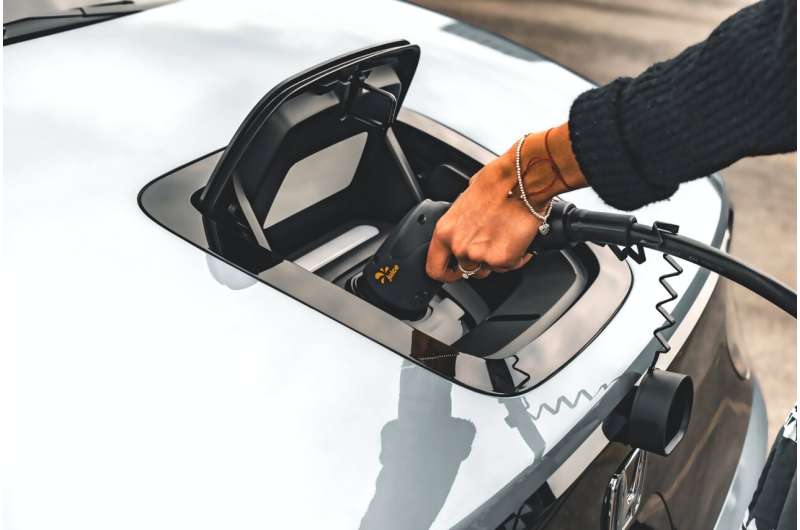This article has been reviewed according to Science X's editorial process and policies. Editors have highlighted the following attributes while ensuring the content's credibility:
fact-checked
trusted source
proofread
What will happen when all those EV batteries reach their end of life?

The federal government and the provincial governments of Ontario and Quebec have committed tens of billions of dollars to the development of electric vehicle (EV) battery-manufacturing facilities and supply chains over the past two years.
Substantial support is also being provided by the federal government and some provinces to subsidize EV purchases for Canadians and for the development of EV charging infrastructure. Regulatory proposals are also under consideration to mandate 100%-zero-emission vehicle sales for light-duty vehicles by 2035.
EVs outperform conventional internal combustion engine vehicles by wide margins in terms of reducing direct emissions of greenhouse gases and other pollutants, as well as in energy efficiency.
Road transportation produces 14% of global GHG emissions. The widespread adoption of EVs is therefore widely accepted as an essential component of effective decarbonization plans.
However, when viewed on a life-cycle basis, the electrification of transportation raises wider sustainability issues, such as:
- The need for increased electricity supply to meet the additional demand flowing from the widespread adoption of EVs;
- The impact and risks associated with the materials and supply chains needed for EV manufacturing, particularly the mining of critical minerals for battery production;
- The management and disposal of end-of-life EV batteries, which are complex manufactured products that may contain materials classified as toxic under the Canadian Environmental Protection Act and other legislation.
The first issue is complex and important. It is being examined through studies by governments, utilities, non-governmental organizations and the academic community. The second and third issues have received much less attention.
The federal government and many provincial governments, including Ontario, are aggressively supporting development of critical mineral resources for EV battery manufacturing. But there has been little action or discussion about what will happen when EV batteries reach their end of life.
That needs to change. Areas of risk and opportunity need to be identified early and frameworks established to address these issues before they become serious problems. The approach taken in Europe could be a model for this.
The significance of end-of-life EV batteries will grow as EV sales are expected to accelerate dramatically to the tens of millions per year over the next decade. Each new EV sale will eventually result in an end-of-life battery that will need to be managed.
In addition to the need to prevent harm to the environment or human health from their disposal, there are also positive outcomes. Materials recovered from end-of-life batteries could substantially reduce the need to mine new critical materials. They could also reduce the negative environmental, health and social impacts associated with these extractive activities.
There is also growing interest in the potential for EV batteries to have "second lives" in electricity grids, supporting the integration of renewable energy sources and providing emergency backup.
In the context of these questions, a study released in October by York University's sustainable energy initiative examined the development of policy and regulatory regimes for the post-consumer management of end-of-life EV batteries in Canada, the United States and the European Union.
Its key finding is that regulatory frameworks for end-of-life EV battery management are essentially non-existent in North America.
B.C. and California were found to be potentially moving in the direction of establishing preliminary regulatory structures. Quebec did launch a voluntary recovery system in June 2023. Other North American jurisdictions, including Ontario, indicated they had no intention to establish any form of post-consumer management framework.
Publicly available information on the actual fate of end-of-life EV batteries in North America is extremely limited.
It has been argued that the value of end-of-life EV batteries to recyclers and manufacturers is high enough to prevent the batteries from ending up in landfills or long-term storage. However, in the absence of any transparency requirements around recovery rates and tracking the fate of end-of-life batteries, it is impossible to substantiate this claim.
In contrast to the situation in North America, end-of-life EV batteries have been managed under a European Union (EU) battery directive since 2006. The EU also adopted an updated regulatory framework in June 2023 that will be binding on all member states.
While weaker than its original proposals, the EU regulation is based on the principle of extended producer responsibility. Manufacturers are required to establish plans for recovery and recycling of end-of-life batteries they make or introduce into the market.
The regulation also establishes systems for tracking the fate of end-of-life EV batteries, including "battery passports" and moves in the direction of requiring a minimum level of recycled materials for new batteries.
Canada needs to develop a national regime for end-of-life EV battery management of its own. It should follow the model of key elements in the new EU regulation. These should include the responsibility of manufacturers and importers to establish recovery and recycling systems, reporting requirements and the use of battery passports to help in tracking, reuse and recycling.
The lack of attention to these questions in Canada while governments invest billions in the development of battery supply chains and manufacturing facilities highlights the need to pay attention to the life-cycle implications of energy transitions.


















